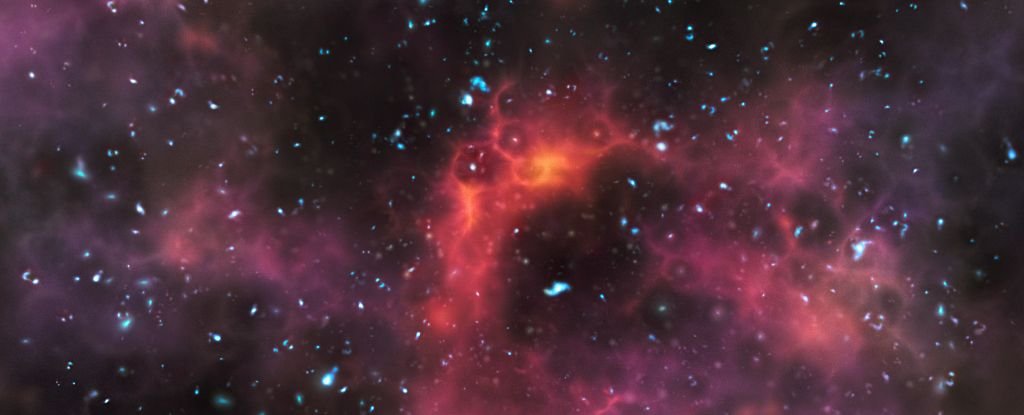Products You May Like
A signal interpreted as the first light illuminating the Universe may not be from the far reaches of the Universe after all, a new study has found. In fact, it may not even be from space.
Far from being a problem, however, this new finding may just set the Universe to rights. The signal, described in two papers in 2018, had some unexpected features that were difficult to explain under current astrophysics.
If the signal was not light from the first stars shining in the early darkness, known as “cosmic dawn”, we don’t need to devise new astrophysics to explain it.
“We report a radiometer measurement of the spectrum of the radio sky in the 55–85 MHz band, which shows that the profile found by Bowman et al. in data taken with the Experiment to Detect the Global Epoch of Reionization Signature (EDGES) low-band instrument is not of astrophysical origin; their best-fitting profile is rejected with 95.3 percent confidence,” writes a team of astronomers led by Saurabh Singh of the Raman Research Institute in India.
“Our non-detection bears out earlier concerns and suggests that the profile found by Bowman et al. is not evidence for new astrophysics or non-standard cosmology.”
The cosmic dawn is an important, and long-sought, period in our Universe’s history. It covers a period from around 50 million up to about a billion years after the Big Bang. Our Universe didn’t always look like it does today; before stars came along, it was filled with a hot murky fog of ionized gas. Light was unable to travel freely through this fog; it simply scattered off free electrons.
Once the Universe cooled down enough, protons and electrons started to recombine into neutral hydrogen atoms. This meant light could finally travel through space. As the first stars and galaxies began to form, around 150 million years after the Big Bang, their ultraviolet light gradually reionized the neutral hydrogen ubiquitous throughout the Universe, allowing the entire spectrum of electromagnetic radiation to stream freely.
By about 1 billion years after the Big Bang, the Universe was completely reionized; earlier than this 1 billion year mark, however, we can’t really see with our current experiments, which makes the reionization process tricky to understand. If we could detect light from the cosmic dawn, it would be an absolute game-changer.
The EDGES experiment was looking for this signal in low radio frequencies, and got a hit, but the signal received wasn’t what astronomers expected. Instead, the amplitude was almost twice as large as had been predicted, suggesting the hydrogen gas the light had passed through was colder than we thought it could be.
The only thing that could have cooled the gas to that degree during this stage of the Universe’s lifespan, the research team concluded, was dark matter; in turn, that dark matter’s properties might be very different from our predictions.
Any extraordinary finding, especially one that may require new science, absolutely warrants further investigation, so Singh and his colleagues used the Shaped Antenna Measurement of the Background Radio Spectrum 3 (SARAS 3) radiometer to see if they could validate the signal.
In early 2020, they floated SARAS 3 out into the middle of remote lakes in Southern India and probed the sky for the signal detected by EDGES.
Once the data had been obtained, processed and analyzed, Singh’s team found there was no signal to be found. Nor did their instrument replicate distortion of the radio spectrum seen in the EDGES data.
“The profile found by Bowman et al. is not detected in the MCMC analysis of the sky spectrum made with the SARAS 3 instrument,” they wrote in their paper.
“Moreover, the correlation analysis shows that the distortion present in the spectrum made using the EDGES low-band instrument, which was used to derive the best-fitting profile and define the bounds on the parameter space for the profile, is not present in the SARAS 3 spectrum of the sky. These facts suggest that the significant spectral distortion present in the sky spectrum made with the EDGES low-band instrument is a systematic error associated with the instrument.”
In other words, the signal, Singh and his team suggest, was an error produced by the EDGES antenna, not a signal emanating from deep into the far reaches of space-time. The sensitivity of the SARAS 3 data, they added, ruled out a cosmological origin for the signal. Ouch.
Generally, when something extraordinarily odd is discovered, the evidence itself also needs to be extraordinary. However, in order to be very certain of whether the signal exists, and what it is, more observations, with different instruments, should be undertaken.
“We conclude,” Singh and his team wrote, “that continued observations with sensors deployed in such environs, such as the SARAS 3 monocone on large water bodies in remote locales on Earth or a space mission in orbit on the lunar farside, would provide data free from systematics and lead to discovery of the true redshifted 21-centimeter signal from the cosmic dawn.”
The results have been published in Nature Astronomy.
